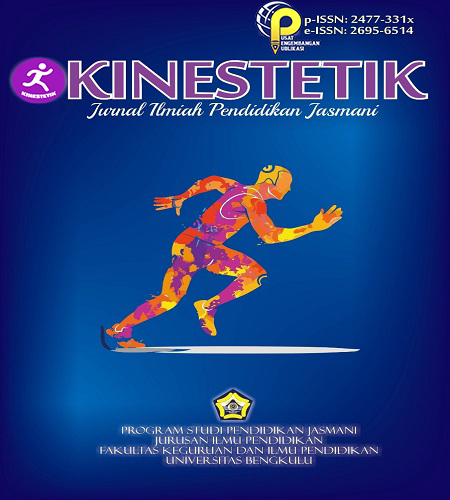Main Article Content
Abstract
Keywords
Article Details
- Authors retain copyright and grant the journal right of first publication with the work simultaneously licensed under a Creative Commons Attribution-ShareAlike 4.0 (CC BY-SA) that allows others to share the work with an acknowledgement of the work's authorship and initial publication in this journal.
- Authors are able to enter into separate, additional contractual arrangements for the non-exclusive distribution of the journal's published version of the work (e.g., post it to an institutional repository or publish it in a book), with an acknowledgement of its initial publication in this journal.
- Authors are permitted and encouraged to post their work online (e.g., in institutional repositories or on their website) prior to and during the submission process, as it can lead to productive exchanges, as well as earlier and greater citation of published work (See The Effect of Open Access).
- This work is licensed under a Creative Commons Attribution-ShareAlike 4.0 International License.
References
- Arawindha, U., & Fitrianita, T. (2018). The Accessibility of People with Disabilities to the Tourism Activities in Batu City. Int'l J. Soc. Sci. Stud., 6, 47.
- Chikuta, O., du Plessis, E., & Saayman, M. (2019). Accessibility expectations of tourists with disabilities in national parks. Tourism Planning & Development, 16(1), 75-92. https://doi.org/10.1080/21568316.2018.1447509
- Danso, A. K., Atuahene, B. T., & Agyekum, K. (2017). Assessing the accessibility of built infrastructure facilities for persons with disabilities: A case of the Softline Interchange. International Conference On Infrastructure Development In Africa.
- Darcy, S., & Buhalis, D. (2010). Introduction: from disabled tourists to accessible tourism. In Accessible Tourism (pp. 1-20). Channel View Publications. https://doi.org/10.21832/9781845411626-004
- Hua, K. P., Ibrahim, I., & Chiu, L. K. (2013). Sport tourism: Physically-disabled sport tourists’ orientation. Procedia-Social and Behavioral Sciences, 91, 257-269. https://doi.org/10.1016/j.sbspro.2013.08.423
- Kaganek, K., Ambro?y, T., Mucha, D., Jurczak, A., Bornikowska, A., Ostrowski, A., ... & Mucha, T. (2017). Barriers to Participation in Tourism in the Disabled. Polish Journal of Sport and Tourism, 24(2), 121-129. doi: 10.1515/pjst-2017-0013
- Mapjabil, J., Marzuki, M., Kumalah, M. J., Tangavello, L., & Abidin, M. K. Z. (2017). Sport as a tourism attraction in Malaysia: Potential and prospects. Geografia-Malaysian Journal of Society and Space, 11(12).
- Mhanna, R. (2018). Sport tourism: new challenges in a globalized world. Journal of Sport Tourism. 24 (4), 349-351. https://doi.org/10.1080/14775085.2018.1532948
- Oetomo, M., Teddy, L., & Adiyanto, J. (2020). Planning and Designing of International Football Stadium in Bengkulu Province (Doctoral dissertation, Sriwijaya University).
- Osmanoglu, H., & Üzüm, H. (2018). Evaluating the Service Quality of the Hotel Establishments in Sports Tourism about the Athletes. Higher Education Studies, 8(2), 29-36. doi:10.5539/hes.v8n2p29
- Pratama, H. F., & Sakti, B. (2016). Development Program In The Long Beach-Based To Tourists And Local Community Perspective. Ekombis Review: Jurnal Ilmiah Ekonomi dan Bisnis, 4(2). https://doi.org/10.37676/ekombis.v4i2.282
- Rahadian, A., Ma’mun, A., Berliana, B., & Nuryadi, N. (2021). Successful Elite Sport Policies: Indonesia at The 2018 Asian Games. Juara: Jurnal Olahraga, 6(2), 288-303. https://doi.org/10.33222/juara.v6i2.1327
- Sanusi, R. (2020). Analysis of Sports Tourism Based on Natural Resources in Karimun Regency. Jurnal Ilmu Keolahragaan, 3(1), 1-9. http://dx.doi.org/10.26418/jilo.v3i1.34999
- Siswanto, A. (2015). Eco-Tourism Development Strategy Balurannational Park in the Regency of Situbondo, East Java, Indonesia. International Journal of Evaluation and Research in Education, 4(4), 185-195.
- Sugiyono. (2017). Penelitian Kuantitatif, Kualitatif, dan R&D. Bandung: Alfabeta.
- Tan, W., & Hasibuan, A. P. S. (2019). The Fulfillment of Cultural and Tourism Rights for Tourists with Physics Disabilities in Batam City. Journal of Judicial Review, 21(2), 145-167.
References
Arawindha, U., & Fitrianita, T. (2018). The Accessibility of People with Disabilities to the Tourism Activities in Batu City. Int'l J. Soc. Sci. Stud., 6, 47.
Chikuta, O., du Plessis, E., & Saayman, M. (2019). Accessibility expectations of tourists with disabilities in national parks. Tourism Planning & Development, 16(1), 75-92. https://doi.org/10.1080/21568316.2018.1447509
Danso, A. K., Atuahene, B. T., & Agyekum, K. (2017). Assessing the accessibility of built infrastructure facilities for persons with disabilities: A case of the Softline Interchange. International Conference On Infrastructure Development In Africa.
Darcy, S., & Buhalis, D. (2010). Introduction: from disabled tourists to accessible tourism. In Accessible Tourism (pp. 1-20). Channel View Publications. https://doi.org/10.21832/9781845411626-004
Hua, K. P., Ibrahim, I., & Chiu, L. K. (2013). Sport tourism: Physically-disabled sport tourists’ orientation. Procedia-Social and Behavioral Sciences, 91, 257-269. https://doi.org/10.1016/j.sbspro.2013.08.423
Kaganek, K., Ambro?y, T., Mucha, D., Jurczak, A., Bornikowska, A., Ostrowski, A., ... & Mucha, T. (2017). Barriers to Participation in Tourism in the Disabled. Polish Journal of Sport and Tourism, 24(2), 121-129. doi: 10.1515/pjst-2017-0013
Mapjabil, J., Marzuki, M., Kumalah, M. J., Tangavello, L., & Abidin, M. K. Z. (2017). Sport as a tourism attraction in Malaysia: Potential and prospects. Geografia-Malaysian Journal of Society and Space, 11(12).
Mhanna, R. (2018). Sport tourism: new challenges in a globalized world. Journal of Sport Tourism. 24 (4), 349-351. https://doi.org/10.1080/14775085.2018.1532948
Oetomo, M., Teddy, L., & Adiyanto, J. (2020). Planning and Designing of International Football Stadium in Bengkulu Province (Doctoral dissertation, Sriwijaya University).
Osmanoglu, H., & Üzüm, H. (2018). Evaluating the Service Quality of the Hotel Establishments in Sports Tourism about the Athletes. Higher Education Studies, 8(2), 29-36. doi:10.5539/hes.v8n2p29
Pratama, H. F., & Sakti, B. (2016). Development Program In The Long Beach-Based To Tourists And Local Community Perspective. Ekombis Review: Jurnal Ilmiah Ekonomi dan Bisnis, 4(2). https://doi.org/10.37676/ekombis.v4i2.282
Rahadian, A., Ma’mun, A., Berliana, B., & Nuryadi, N. (2021). Successful Elite Sport Policies: Indonesia at The 2018 Asian Games. Juara: Jurnal Olahraga, 6(2), 288-303. https://doi.org/10.33222/juara.v6i2.1327
Sanusi, R. (2020). Analysis of Sports Tourism Based on Natural Resources in Karimun Regency. Jurnal Ilmu Keolahragaan, 3(1), 1-9. http://dx.doi.org/10.26418/jilo.v3i1.34999
Siswanto, A. (2015). Eco-Tourism Development Strategy Balurannational Park in the Regency of Situbondo, East Java, Indonesia. International Journal of Evaluation and Research in Education, 4(4), 185-195.
Sugiyono. (2017). Penelitian Kuantitatif, Kualitatif, dan R&D. Bandung: Alfabeta.
Tan, W., & Hasibuan, A. P. S. (2019). The Fulfillment of Cultural and Tourism Rights for Tourists with Physics Disabilities in Batam City. Journal of Judicial Review, 21(2), 145-167.
